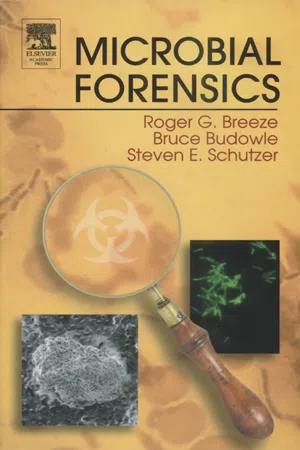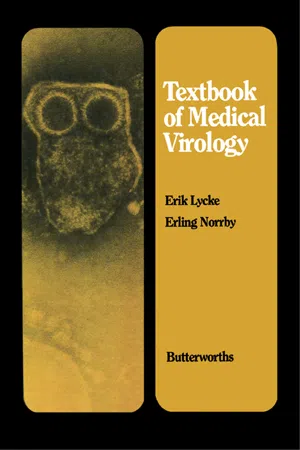Biological Sciences
Positive Sense RNA Viruses
Positive sense RNA viruses have a single-stranded RNA genome that can be directly translated by host cell ribosomes into viral proteins. This means that the RNA can function as messenger RNA (mRNA). Examples of positive sense RNA viruses include the common cold virus (rhinovirus) and the hepatitis C virus. These viruses are significant in both human health and in the study of virology.
Written by Perlego with AI-assistance
Related key terms
4 Key excerpts on "Positive Sense RNA Viruses"
- eBook - ePub
- Bruce Budowle, Steven E. Schutzer, Roger G. Breeze(Authors)
- 2005(Publication Date)
- Academic Press(Publisher)
Fifteen families of the 21 virus families that cause major human diseases contain an RNA genome. Four useful generalities can be applied to virus families that contain RNA genomes. All of the RNA virus families maintain an exclusively cytoplasmic life cycle, except for three [retroviruses (which go through a DNA intermediate) and the two RNA viruses that use the cellular splicing machinery (orthomyxo- and bornaviruses)]. All but four of the RNA viruses are enveloped—only the picornaviruses, astroviruses, caliciviruses, and reoviruses contain naked capsids. With the exception of the double-stranded RNA genomes of the reovirus family, all RNA virus families contain single-stranded genomes. These single-stranded RNA genomes can be of mRNA sense (i.e., positive sense), complimentary to mRNA (negative sense), or a combination of both (ambisense). Finally, most RNA viruses have nonsegmented genomes, with the exception of three families—orthomyxoviruses, bunyaviruses, and arenaviruses. An overview of the 15 families of RNA viruses based on their molecular properties and life cycles is presented below.POSITIVE-SENSE RNA VIRUSES
There are six families of RNA viruses that contain a single-stranded genomic RNA molecule of message-sense. The genomic nucleic acid of positive-sense RNA viruses is fully infectious when delivered to cells in the absence of viral proteins. The gene expression strategies of these agents fall into three groups. The least complex is illustrated by the picornaviruses and flaviviruses. These agents have a single large open reading frame that encodes a single large polyprotein that is subsequently cleaved in an ordered fashion by proteases to generate individual functional polypeptides. Cap-independent translation was discovered in picornaviral internal ribosome entry site elements located in the 5′ noncoding region of the genome. Togaviruses, astroviruses, and caliciviruses generate two or more individual polyproteins that are encoded by the genome, as well as subgenomic mRNAs that are generated during infection. Coronaviruses use the most complex strategy. Instead of generating a polyprotein, numerous subgenomic mRNAs are made from their large genomes, each encoding an individual protein. Recombinant togaviruses that encode subgenomic mRNAs capable of producing large amounts of proteins of interest have been developed. Therefore in addition to naturally occurring positive-sense RNA viruses, the possibility that designer viruses may be responsible for suspicious outbreaks cannot be overlooked.Picornaviruses are a family of small stable viruses, most of which can survive the harsh environment of the gut and be recovered from stool samples. There are five key genera of picornaviruses. Poliovirus, a rather ineffective pathogen that can infect the central nervous system (CNS) and cause poliomyelitis, is eradicated in many parts of the world due to the use of highly effective killed and attenuated vaccines. Select members of the 30+ serotypes of echoviruses are among the most commonly isolated viruses from stools, and cause a variety of disease symptoms including meningitis, encephalitis, rashes, diarrhea, upper respiratory infections, and conjunctivitis. Coxsackieviruses (29 serotypes) are also rather commonly isolated from humans and cause hand, foot, and mouth disease (which is distinct from the animal virus that wreaked havoc on British livestock in 2000), herpangina, pleurodynia, and myocarditis in addition to a variety of nonspecific symptoms. Hepatitis A virus, the agent that causes acute infectious hepatitis, is also a member of the picornavirus family. The final branch of the human picornavirus family tree, rhinovirus, contains over 100 serotypes and causes the common cold. The biology of rhinoviruses is unique from other picornaviruses in that the virions are not stable to low pH, and the agent prefers growing at lower temperatures (33°C vs. 37°C). These properties are reflected in the restriction of rhinovirus infections to the upper respiratory tract. - eBook - ePub
- David P. Clark(Author)
- 2009(Publication Date)
- Academic Cell(Publisher)
Their most famous member is the rotavirus (Fig. 17.17) which causes infant diarrhea, a disease infecting vast numbers of babies and small children. Figure 17.17 Rotaviruses Have Multiple Double-Stranded RNA Molecules Rotavirus particles have two protein coats that encapsulate about a dozen double-stranded RNA molecules. Each of the dsRNA pieces encodes one of the proteins necessary for viral survival and propagation. Positive-Stranded RNA Viruses Make Polyproteins Picornaviruses are small, spherical single-stranded RNA viruses. They include polio, common cold, hepatitis A, and foot and mouth disease. Their genome is long enough for about a dozen genes. Since they are positive-strand RNA viruses, their RNA can be directly used as mRNA. The viral RNA does have a poly(A) tail attached to its 3′-end but has no cap. Instead a protein, the Vpg protein, is attached covalently to the 5′- end of the virus RNA. However, there is a technical problem. Unlike bacteria wherea single mRNA molecule may code for several proteins (an operon; see Ch. 6), in higher organisms each molecule of mRNA only encodes a single protein. Eukaryotic ribosomes will only translate the first reading frame on an RNA message, even if it carries several. Picornaviruses do indeed use their positive ssRNA molecule directly as a messenger RNA. They avoid the problem by using the RNA to code for a single giant polypeptide that uses all of their genetic information (Fig. 17.18).This “polyprotein” is then chopped up into 10 to 20 smaller proteins. Figure 17.18 Polyprotein Strategy of Plus Strand RNA Viruses Rather than having many positive single-stranded RNA molecules, the picornaviruses have one large positive ssRNA molecule (top). Translation of the ssRNA produces a large polyprotein that is cleaved into successively smaller pieces. In Stage I the structural proteins are cleaved from the replicative proteins. In Stage II the segments are cleaved into separate proteins - eBook - ePub
- Erik Lycke, Erling Norrby(Authors)
- 2014(Publication Date)
- Butterworth-Heinemann(Publisher)
Chapter 6 ). Several differences in replication of various kinds of RNA viruses can be noted. The virus-genome determines the duration of the infectious cycle. Polioviruses, in general, replicate completely within 5–6 hours whereas other RNA viruses, such as orthomyxoviruses and reoviruses, require about 10–24 hours.Classes of RNA viruses
Different RNA viruses require different procedures for transcription and replication. Since messenger-RNA (mRNA) is required for the translation process at the cellular ribosomes, this molecule has been defined as the positive (plus) strand of RNA. By definition of the structural relationships between viral mRNA and the nucleic acid which represents the viral genome six different classes of viruses can be distinguished(Figure 8.1 ). Classes I and II include viruses which have a double-stranded and single-stranded DNA, respectively.Figure 8.1 Division of animal viruses into classes based on their mechanism of transcription (according to Baltimore 1971 ). The basic concept behind this division is that virus-mRNA always represents the RNA chain with plus-strand polarity.(Reproduced from Baltimore (1971) by permission of the American Society for Microbiology, Washington, DC, USA.)Among RNA viruses four different classes can be distinguished. Double-stranded RNA viruses, i.e. reoviruses, belong to class HI. In these viruses the double-stranded virion-RNA is the template for formation of asymmetrical mRNA. All viruses belonging to class III appear to have a segmented genome, i.e. several pieces of nucleic acid each of which code for one polypeptide. Class IV includes plus-stranded RNA viruses, i.e. the RNA in virions has the same polarity as viral mRNA. Two subclasses of these viruses have been identified. Polioviruses and other picornaviruses belong to class IV A. The mRNA of these viruses has the same length as virion-RNA. This mRNA molecule is translated into one polyprotein which then is cleaved proteolytically to form functional structural and replication proteins. Togaviruses belong to class IVB. These viruses synthesize two different forms of mRNA in cells. One form of mRNA has the same size as virion-RNA whereas the other form of mRNA only amounts to a fraction of the total genome. The latter mRNA is synthesized separately from the 3′ end of minus-strand RNA and codes for structural proteins. Class V viruses are frequently referred to as negative (minus) strand RNA viruses. This class includes rhabdoviruses, orthomyxoviruses, paramyxoviruses, bunyaviruses and arenaviruses. In all these viruses virion-RNA is complementary to mRNA. Thus the virion-RNA does not contain any sequences coding for proteins, but can only serve as a template for the formation of mRNA. Since the cell does not have the capacity to replicate RNA molecules, the virions have to include a polymerase which can transcribe RNA. At least two subclasses of class V viruses can be distinguished. Class VA viruses, which include rhabdoviruses and paramyxoviruses, have one single molecule of virion-RNA and form a series of mRNAs from this template. Each of these mRNAs appear to be monocistronic and thus code for one protein. Class VB, represented by orthomyxoviruses, have a segmented minus-strand RNA and each molecule serves as a template for synthesis of mRNA. It has been assumed also that these mRNAs are monocistronic but recent findings have demonstrated that splicing occurs after transcription of these viruses which allows some of the RNA segments to direct the synthesis of more than one protein. Finally, class VI includes retroviruses. These viruses are similar to class IV viruses in that virion-RNA corresponds to mRNA, but synthesis of mRNA after infection must take place via a DNA intermediate, which most likely needs to become integrated into the cellular genome. The capacity to synthesize DNA from RNA is absent in the host cells and therefore retroviruses also by necessity contain polymerases in the virions. - eBook - ePub
- Sabyasachi Dash, Sabyasachi Dash(Authors)
- 2023(Publication Date)
- CRC Press(Publisher)
The virus family concept is fundamentally important in understanding the biological classification of viruses. By specifying the family to which a virus belongs, much can be inferred about its physical, chemical, and biologic properties and its evolutionary relationships including modes of gene expression. Virus families are designated with the suffix -viridae. Families are distinguished largely based on physiochemical properties, genome structure, size, morphology, and molecular processes. Viruses are microscopic obligate intracellular parasites which contain either an RNA or DNA genome surrounded by a protective protein coat called a capsid (2). Viruses can be classified based on their morphology, chemical composition, structure of the genome, and various modes of replication, as shown in Figure 2.1. The viral genome may either be single stranded (ss) or double stranded (ds) and is packaged in either a linear or circular arrangement. The entire genome may either constitute a single nucleic acid molecule (monopartite) or multiple copies of the nucleic acid molecule (multipartite). Such different types of genomes necessitate different replication strategies based on their genomic structure. RNA viruses are of two types: single-stranded RNA (ssRNA) and double-stranded RNA (dsRNA). The single-stranded RNA viruses are further classified as (1) [+ssRNA], plus strand, or positive strand; and (2) [−ssRNA], minus strand, or negative strand. Viruses are also classified based on their morphology into two main categories: (1) enveloped, which have a lipid membrane (envelope); and (2) non-enveloped, which lack a membrane. Given the shape, helical morphology is seen in nucleocapsids of several filamentous and pleomorphic viruses. Helical nucleocapsids consist of a helical array of capsid proteins called protomers wrapped around a helical filament of nucleic acid. On the other hand, icosahedral morphology is characteristic of the nucleocapsids of several spherical viruses
Index pages curate the most relevant extracts from our library of academic textbooks. They’ve been created using an in-house natural language model (NLM), each adding context and meaning to key research topics.



